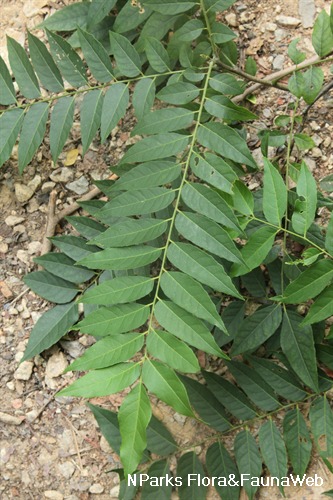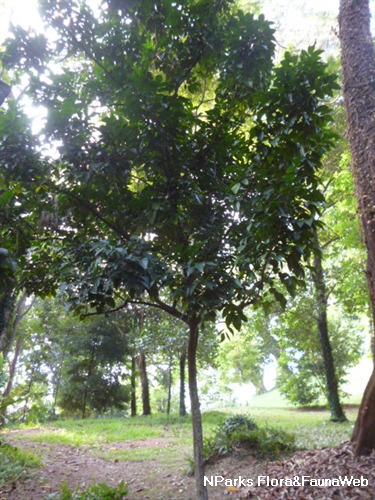
Back
Clausena excavata Burm.f.
| Family Name: | Rutaceae |
| Common Name: | Pink Lime-Berry, Cama, Cemama, Cemamar, Cerek, Cerek Hitam, Kemantu Hitam, Secerek, Semeru, Suntang Hitam, 假黄皮 |
Name
Classifications and Characteristics
| Plant Division | Angiosperms (Flowering Seed Plants) (Dicotyledon) |
|---|---|
| Plant Growth Form | Tree (Small (6m-15m)), Shrub |
| Lifespan (in Singapore) | Perennial |
| Mode of Nutrition | Autotrophic |
| Plant Shape | Irregular |
| Maximum Height | 15 m |
Biogeography
| Native Distribution | India, Myanmar, south China, Taiwan, southern Thailand through Malaysia, Singapore, the Philippines, Indonesia, and Brunei to Papua New Guinea |
|---|---|
| Native Habitat | Terrestrial (Primary Rainforest, Secondary Rainforest) |
| Preferred Climate Zone | Tropical |
| Local Conservation Status | Native to Singapore (Least Concern (LC)) |
Description and Ethnobotany
| Growth Form | It is a evergreen shrub or tree up to 15 m tall, covered with hair, with slender leaves hanging freely at the end of the branches. A strong smell of resin, lime and ivy is also emitted when the plant is crushed. |
|---|---|
| Foliage | Its leaves are 20–61 cm long, with 7–20 pairs of leaflets. Its alternate, short-stalked leaves have thinly leathery leaf blades that are oblong-egg-shaped to lance-shaped or slightly crescent-shaped, 2–20 by 1–7 cm, and with asymmetrical bases. They also have slightly wavy or faintly notched margins. |
| Flowers | Its green flowering shoots are 10–45 cm long, and found from the end of leafy twigs, or at the leaf axils. They bear flowers that are about 7.6–10 mm wide, and yellowish or greenish. |
| Fruit | Its smooth fruits are broadly ellipsoid, 0.8–2 cm long, ripen green then white or pinkish, and found in hanging shoots. They emit a smell of sour, resinous oranges when crushed. Each fruit also contains 1–2 green seeds. |
| Associated Fauna | Its flowers are insect-pollinated. It is also the preferred local food plant for caterpillars of the butterflies, the emerald swallowtail (Papilio palinurus), and the lime butterfly (Papilio demoleus malayanus). The adult of the latter lays its eggs singly on the young leaves of the host plant. Its fruits are probably eaten by birds. |
| Cultivation | It can be propagated by seed. |
| Etymology | Latin Clausena, commemorating Clausen, a botanist known to Burmann; Latin excavatus, to make hollow, referring to the bases of the filaments (stalks of stamens) |
Landscaping Features
| Landscaping | It may be suitable for parks. |
|---|---|
| Desirable Plant Features | Fragrant (Foliage) |
| Landscape Uses | General, Parks & Gardens, Small Gardens |
Fauna, Pollination and Dispersal
| Fauna Pollination Dispersal Associated Fauna | Bird-Attracting (Fruits), Butterfly Host Plant (Leaves) |
|---|---|
| Pollination Method(s) | Biotic (Fauna) |
| Seed or Spore Dispersal | Biotic (Fauna) |
Plant Care and Propagation
| Light Preference | Full Sun, Semi-Shade |
|---|---|
| Water Preference | Moderate Water |
| Plant Growth Rate | Moderate |
| Rootzone Tolerance | Moist Soils, Fertile Loamy Soils |
| Maintenance Requirements | Moderate |
| Propagation Method | Seed |
Foliar
| Foliage Retention | Evergreen |
|---|---|
| Mature Foliage Colour(s) | Green |
| Mature Foliage Texture(s) | Leathery, Thin |
| Foliar Type | Compound (Odd-Pinnate) |
| Foliar Arrangement Along Stem | Alternate |
| Foliar Attachment to Stem | Petiolate |
| Foliar Shape(s) | Non-Palm Foliage |
| Foliar Venation | Pinnate / Net |
| Foliar Margin | Entire - Wavy / Undulate |
| Foliar Apex - Tip | Acute |
| Foliar Base | Oblique / Asymmetrical |
Floral (Angiosperm)
| Flower & Plant Sexuality | Bisexual Flowers |
| Flower Colour(s) | Green, Yellow / Golden |
|---|---|
| Flower Grouping | Cluster / Inflorescence |
| Flower Location | Axillary, Terminal |
Fruit, Seed and Spore
| Mature Fruit Colour(s) | Pink, White |
|---|---|
| Fruit Classification | Simple Fruit |
| Fruit Type | Fleshy Fruit , Non-Accessory Fruit |
Image Repository
Others
| Master ID | 29366 |
|---|---|
| Species ID | 3675 |
| Flora Disclaimer | The information in this website has been compiled from reliable sources, such as reference works on medicinal plants. It is not a substitute for medical advice or treatment and NParks does not purport to provide any medical advice. Readers should always consult his/her physician before using or consuming a plant for medicinal purposes. |







